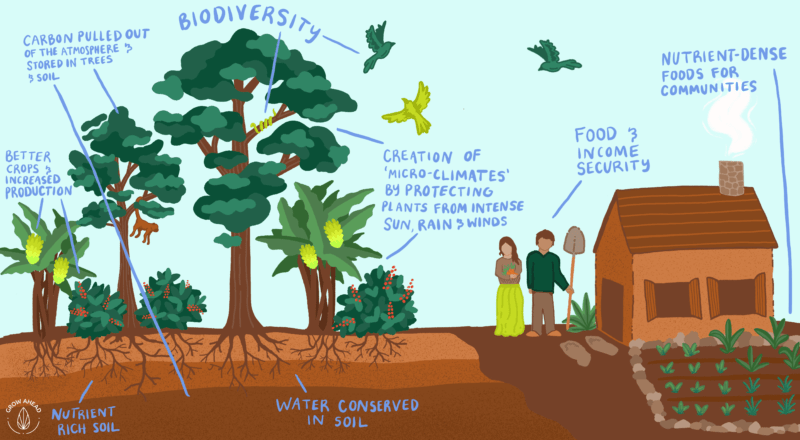Agroforestry & Food Security For Small-Scale Farming Communities
Agroforestry is a system of land management in which trees are deliberately planted with agricultural crops to emulate native forestry systems. Farmers and Indigenous communities have been planting crops and trees together in food-forest systems for thousands of years. In recent years, agroforestry has become increasingly recognized as a method of land management that sequesters carbon and has many mutually reinforcing benefits. By integrating trees with existing agricultural activities, farmers increase economic, social, and environmental benefits, one being enhanced food security. Food security is a multi-faceted term that relates to food availability, food accessibility, food utilization, and food stability. Agroforestry targets all of these aspects by providing food directly to increase availability, creating income to increase food accessibility, providing fuel for cooking to address food utilization, and by supporting other ecosystem services to ensure food stability.
Growing Food and Diversifying Income
One of the most visible ways incorporating trees into existing agricultural practices improves food security is through the food that grows on the trees themselves. By planting a mix of Indigenous and exotic fruit trees, farmers are growing nutritionally dense foods, diversifying income streams, and spreading production to ensure a year-long supply of food. During periods of increasing food prices or harvest failures, farmers can rely on their fruit trees to act as a safety net and provide a reliable supply of food or source of income. Traditionally, these nutrient-dense foods have been collected from forests and woodlands, with the work mainly being done by women. However, deforestation and increasing pressures on forests have limited the natural availability of these products, making it even more essential for farmers to produce their own supply in order to mitigate the risk of malnutrition.
Another way agroforestry enhances food security is by generating income to increase access to food. Food insecurity and poverty are closely linked, as supplying a means to reduce poverty results in a parallel reduction of food insecurity. Planting a variety of trees and crops is crucial in two ways: diversity ensures consistent income, and diverse, consistent income ensures one is not relying on income from a single commodity crop, which can lead to food insecurity when farmers are vulnerable to payments that are one-off, delayed, or unpredictable in value. We see this in action in Grow Ahead’s project with SOPPEXCCA in Nicaragua. The women of SOPPEXCCA have been developing the first organic farmers market in Jinotega. They are diversifying their income and bringing fruits, vegetables, and other products to a city of 130,000 people who have little access to chemical-free food. Relying on monocultures also reduces farmers’ resilience to shocks such as drought, flood, and the outbreak of pests and diseases, which decrease food security. A diverse range of trees also offers different income possibilities.
Bolsters Essential Ecosystem Services and Mitigates Climate Change
Agroforestry systems support ecosystem services that further reduce food insecurity. Planting trees alongside crops creates microclimates that shade crops from intense sun and rain and protect from pests, erosion, and floods; supports animal production; and improves soil fertility. Agroforestry also supports populations of pollinator species such as insects and birds that are essential for many crops. Farmers like the Maya Ixil Cooperative in Guatemala are integrating beekeeping with agroforestry systems in order to increase biodiversity and contribute to food security goals. Increased biodiversity that comes from integrating trees into agricultural land contributes to food and nutrition security of rural farmers. If one crop fails, biodiversity along the lines of varied crops on the farm or in the neighboring landscape offers opportunities and alternatives for food and income.
Due to the massive threat that it poses, climate change mitigation is becoming a top priority for small-scale farmers. Until now, most mitigation efforts have not led to short-term increases in income or welfare. Small-scale farmers now see agroforestry as a way to mitigate the impacts of climate change while increasing their food security. Given this, the greatest opportunity to sequester carbon on a large scale is through innovations that simultaneously support people and the planet.
Path for the Future
By adopting agroforestry practices, smallholder farmers are able to increase their food security while simultaneously sequestering carbon from the atmosphere, thereby bettering their economic opportunities and enhancing other essential ecosystem services. Through appropriately combining plants, animals, and trees in agroforestry systems, farmers not only increase farm yields, therefore increasing food security, but also promote ecological and social resilience to change. These benefits are being seen around the world in places where farmers are incorporating agroforestry, therefore becoming a risk reduction strategy that is recognized for its adaptation and mitigation roles.
Grow Ahead supports community-led agroforestry projects that offer wide-reaching, mutually reinforcing benefits; these investments are what are needed to ensure smallholder farmers’ survival in the face of climate change. Learn more and support a project!
Written by Talia White and Julia Gentner

